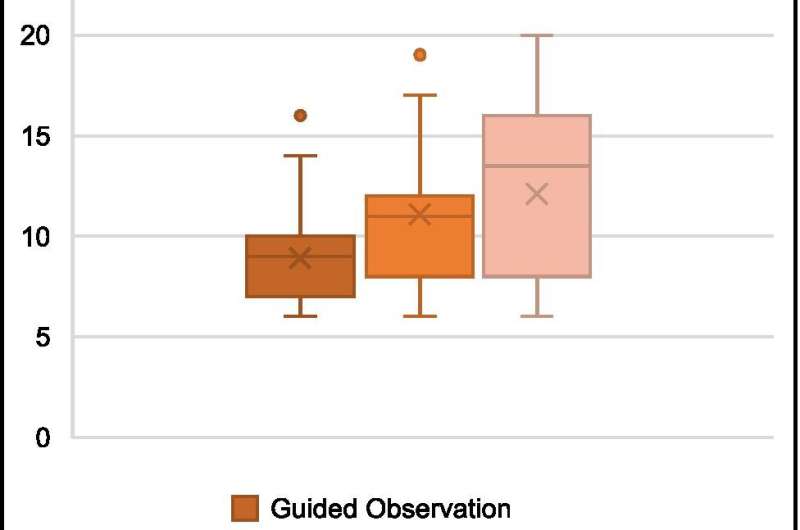Study finds art at the bedside of cancer patients is good medicine

The simple distraction of looking at art and discussing it helped bring calm to a group of patients at the Wilmot Cancer Institute—and also provided moments of Zen for the medical student who led the study.
The daughter of an artist and former fashion designer, Emily Gore, a fourth-year student at the University of Rochester School of Medicine and Dentistry, was looking for a research project that would marry her love of art with medicine. The results of her randomized clinical trial are reported in the journal Supportive Care in Cancer, showing that anxiety was significantly lower among patients who viewed art at the bedside.
Gore recognized the isolation of hospitalized cancer patients, having to cope with visitor restrictions due to COVID-19 and the immunosuppression that puts them at great risk for infection.
She and her mentor, Susan Dodge-Peters Daiss, M.A., M.Div., senior associate in Health Humanities and Bioethics at the UR Medical Center, who has a background in chaplaincy and museum education, curated dozens of art images online, ranging from landscapes to paintings of flowers, angels, and animals. The images were loaded onto an iPad, which was protected by a plastic sleeve to avoid transmission of germs.
Their art therapy library included images from the UR's Memorial Art Gallery, the National Gallery in Washington D.C., the Metropolitan Museum of Art in New York, and other galleries from around the world.
Their study included 73 patients; the objective was to compare anxiety levels between trial participants and a control group that did not view the art.
Easing boredom and loneliness
Pictures of animals were Melissa Ogletree's favorites.
"I joke that I spend half my time on puppy TikTok because it makes me smile," said the 41-year-old Fairport woman. "Seeing the art really brightened my day."
Cancer struck Ogletree suddenly and unexpectedly in February of 2021.
She had not been feeling well for a few weeks with fever, headaches, exhaustion and ear-ringing. A telehealth doctor initially suspected COVID—but when her own doctor insisted on blood tests and the results came back, he called Ogletree at 10 p.m. on a Thursday and told her to rush to the Emergency Department.
"I'm a single mom of a son who was 13 at the time," she recalled. "I tried not to panic, packed my bag, and called my Dad. It was a long night. I had multiple blood transfusions and was transferred to Wilmot's sixth floor."
The diagnosis was acute lymphocytic leukemia, placing her in and out of the hospital during much of the year.
"During hospital stays it's very easy to get lonely and bored," Ogletree said. "Being a social person, that was the hardest part. The world outside keeps going and you are in the hospital, isolated. The pictures helped, and provided a distraction."
In addition to Gore's art therapy study, Ogletree also participated in a clinical trial evaluating a leukemia medication that's more targeted than chemotherapy.
"I'm pro-clinical trial and a big believer in science," Ogletree said, noting that her oncologists and the oncology nurses were "phenomenal" about answering questions and sharing resources.
Ogletree is a two-time cancer survivor, having had thyroid cancer seven years ago. Although she is still undergoing out-patient treatment for leukemia, her latest biopsies are clean and she is working on rebuilding her immune system.
Making a difference
Gore's art project evolved from an existing program offered by chaplaincy services at Strong Memorial Hospital. It has been used in palliative care and on rehabilitation units at the medical center. Gore expanded it and tailored the program for patients who were admitted to Wilmot, some of whom were receiving treatment from Wilmot's Blood & Marrow Transplant and Cellular Therapies specialty unit.
Many of them told Gore: "Thank you so much for doing this; I needed it,'" she said.
The impromptu discussions with patients while viewing art were Gore's favorite part of the study. One patient allowed the art to transport her to a childhood home in Europe, and to muse about recent vacations. She and Gore discovered a shared affinity for the Finger Lakes. Many of the patients enjoyed landscapes that reminded them of the beauty of upstate New York.
The images sparked a variety of emotions. One patient preferred soft-stroke pictures with blues and greens because anything with red was reminiscent of blood draws. Another appreciated the opportunity to ponder the meaning of the art, the study noted.
"When I first started this project, I was just a second-year student and still learning how to talk to patients," Gore said. "But I was able to make a difference, and the patients really enjoyed what I offered to them. It was exciting and incredibly meaningful to bring all of my interests together in this way—during the stress of medical school."
More information: Emily Gore et al, The therapeutic potential of bedside art observation in hematologic cancer inpatients: a randomized controlled pilot study, Supportive Care in Cancer (2022). DOI: 10.1007/s00520-021-06747-z




















